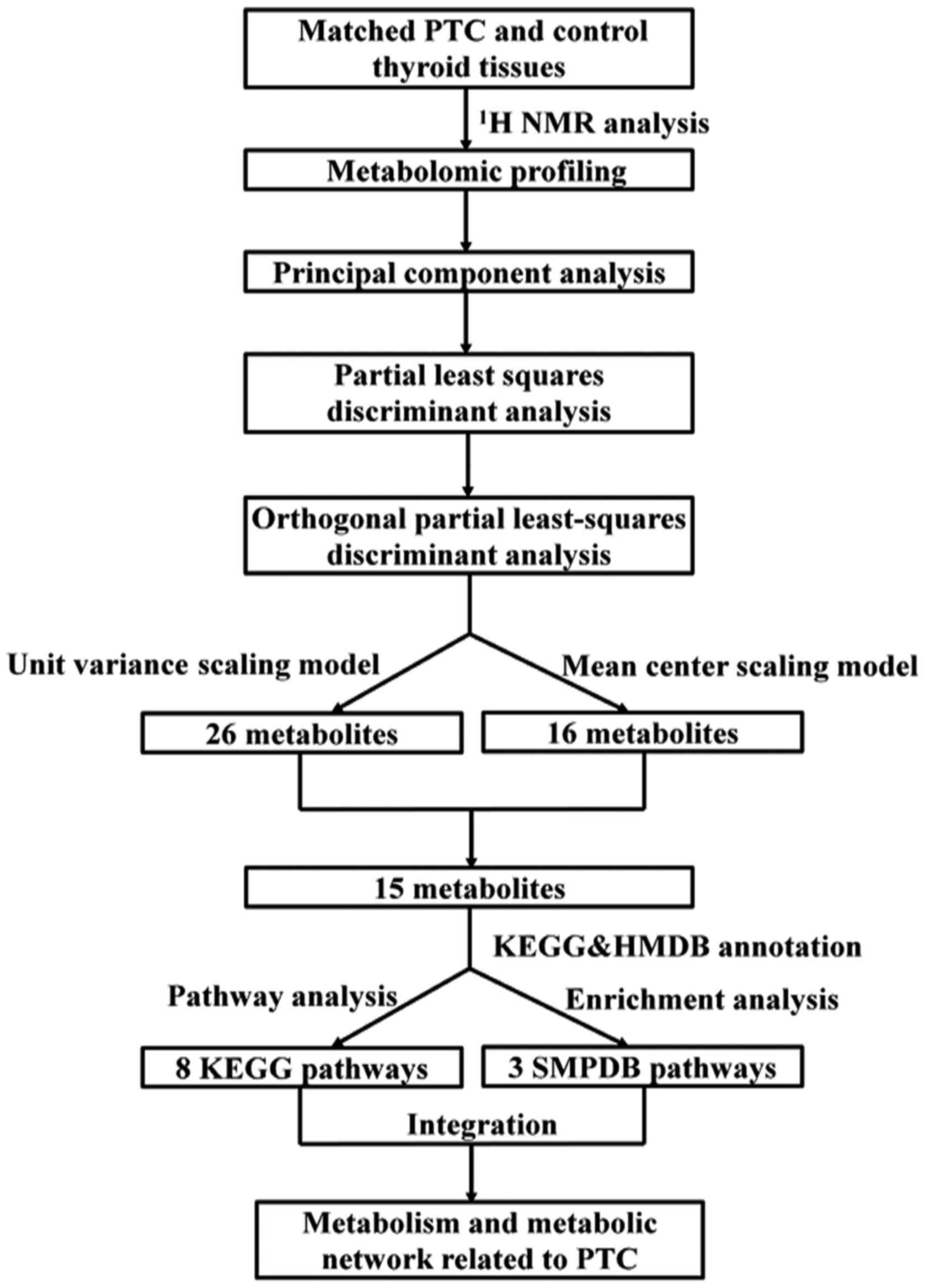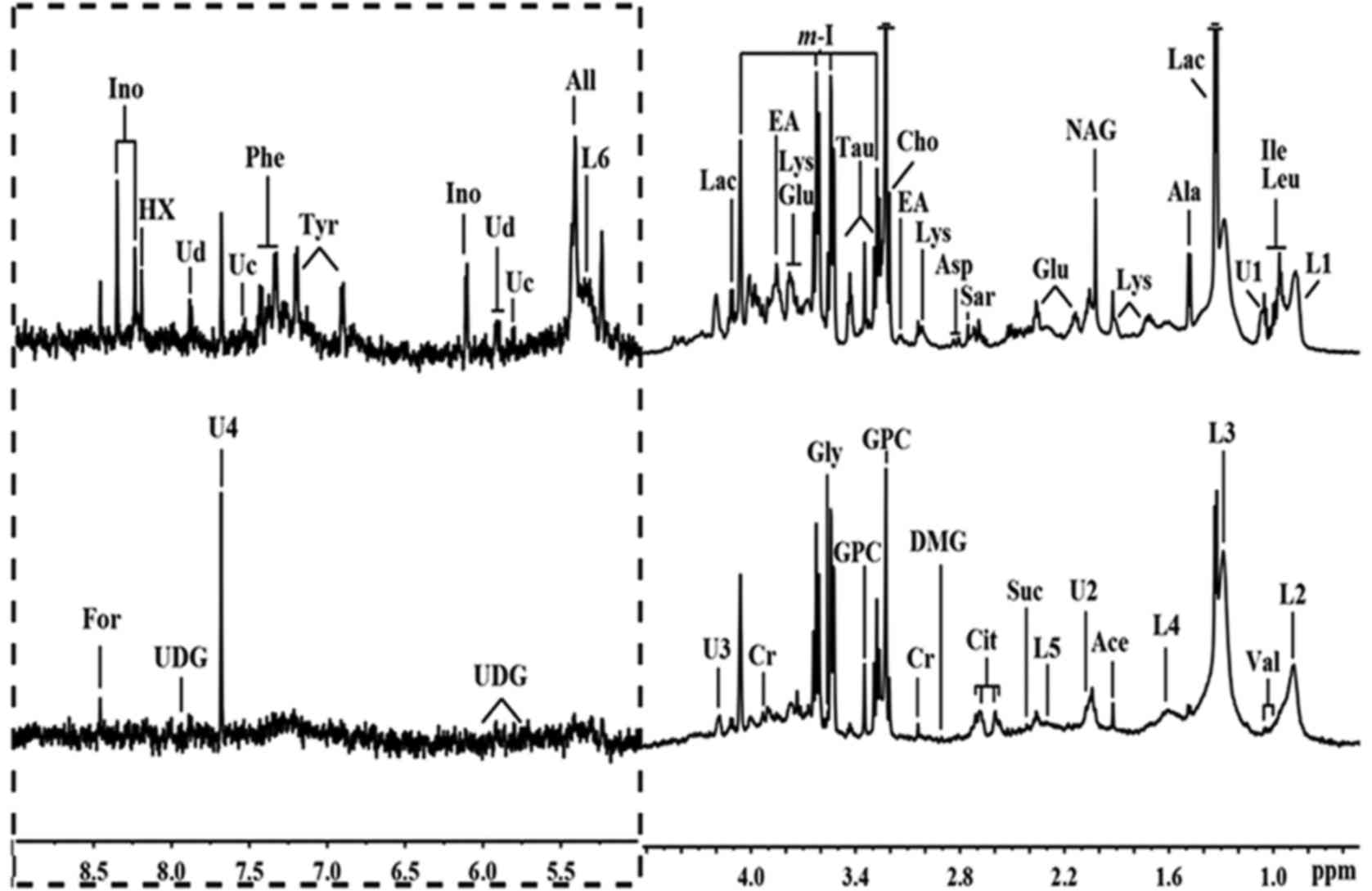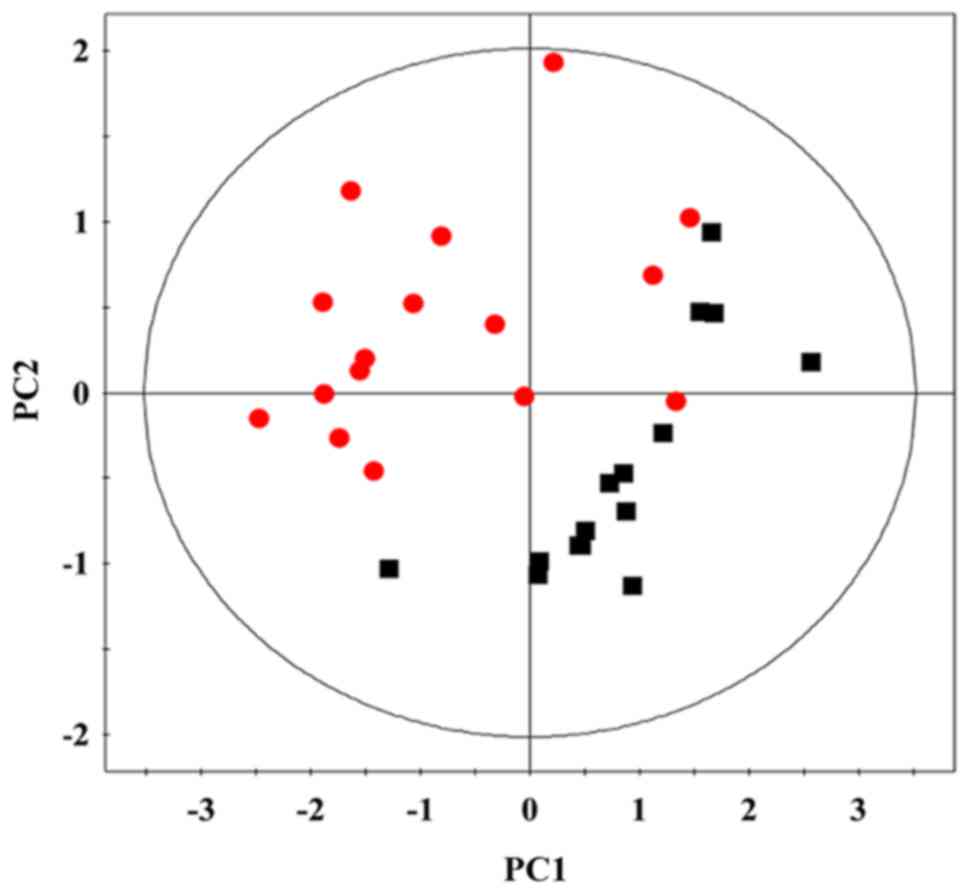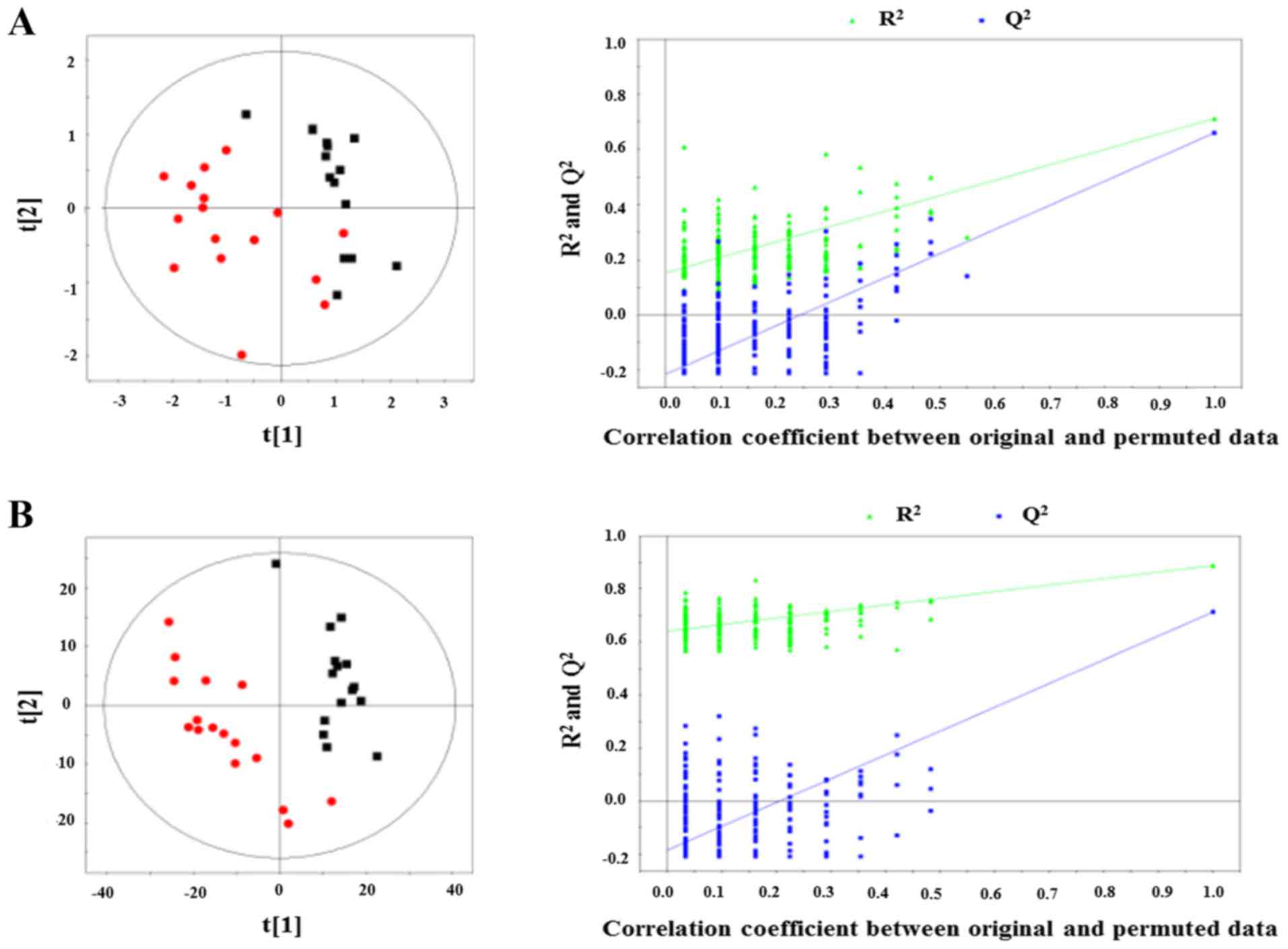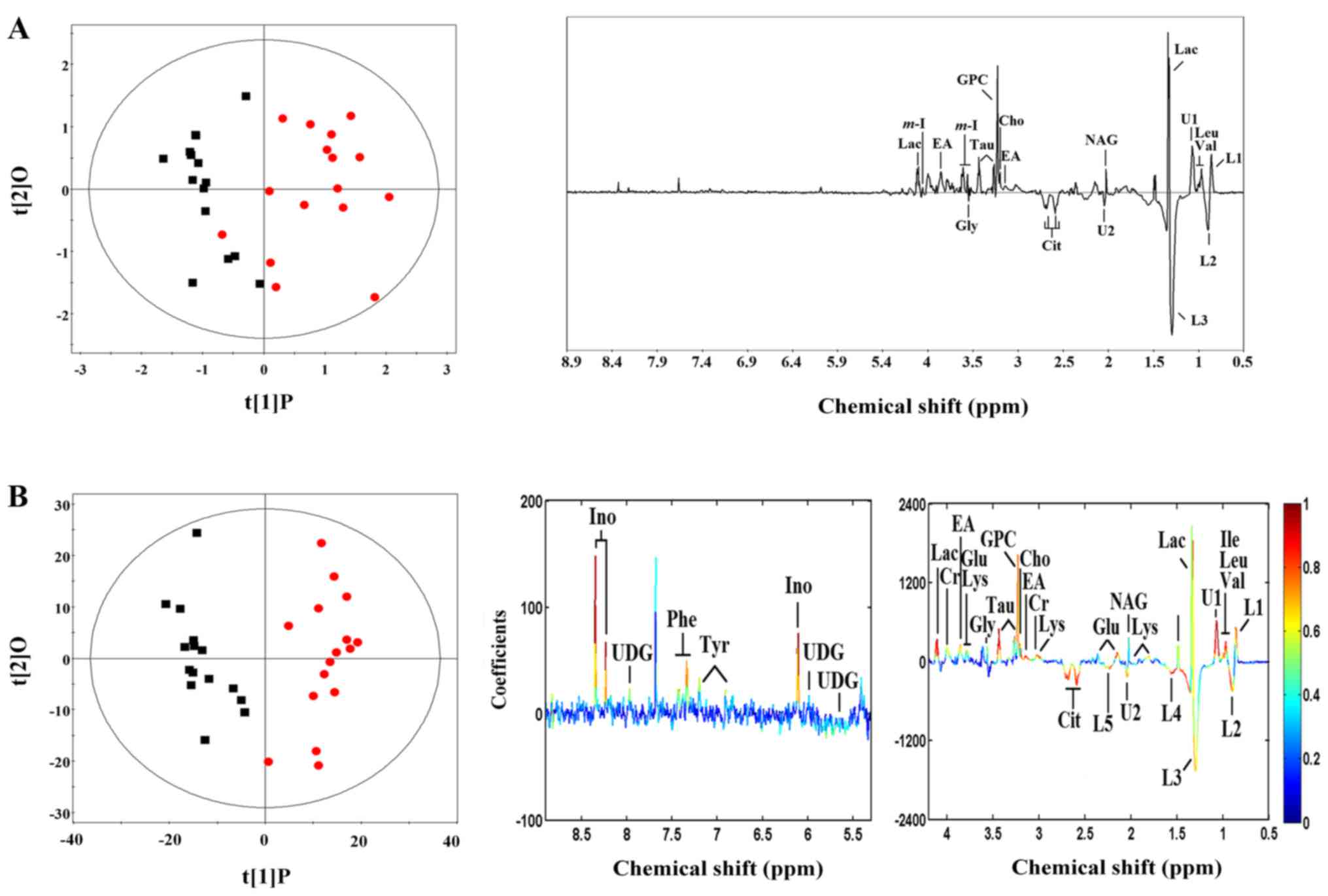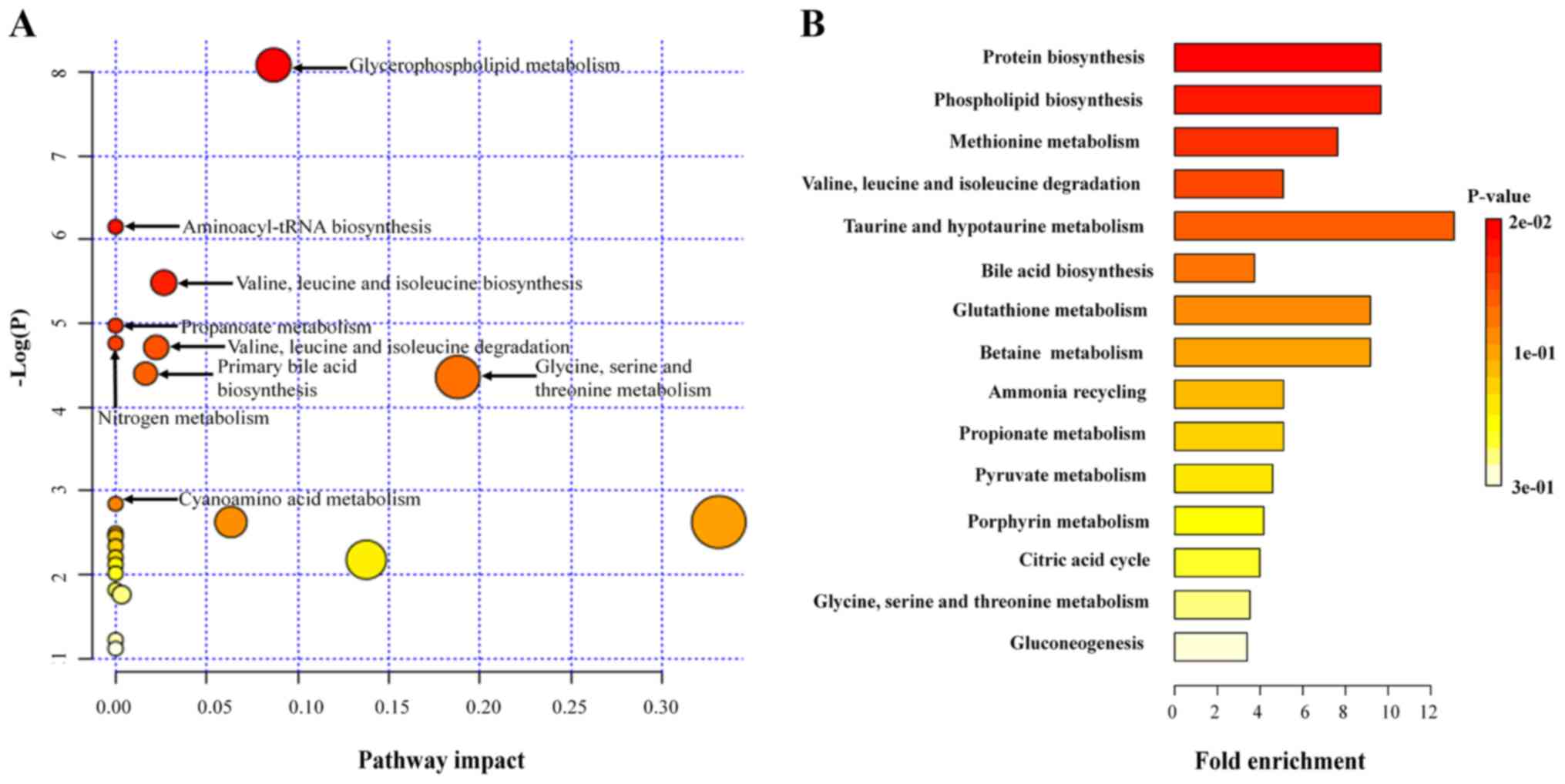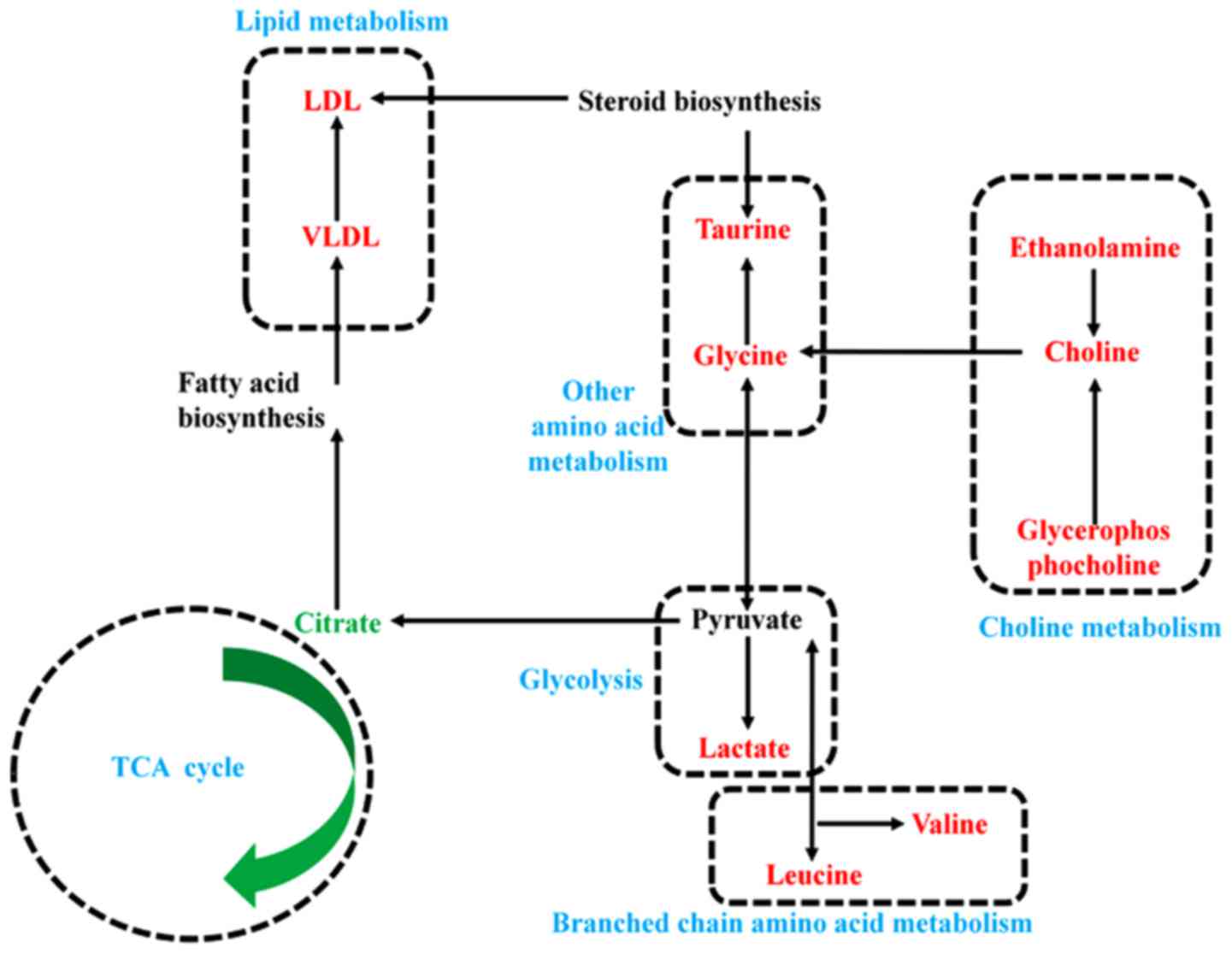|
1
|
Jemal A, Siegel R, Ward E, Hao Y, Xu J,
Murray T and Thun MJ: Cancer statistics, 2008. CA Cancer J Clin.
58:71–96. 2008. View Article : Google Scholar : PubMed/NCBI
|
|
2
|
Cheng LL, Burns MA, Taylor JL, He W,
Halpern EF, McDougal WS and Wu CL: Metabolic characterization of
human prostate cancer with tissue magnetic resonance spectroscopy.
Cancer Res. 65:3030–3034. 2005. View Article : Google Scholar : PubMed/NCBI
|
|
3
|
Brindle JT, Antti H, Holmes E, Tranter G,
Nicholson JK, Bethell HW, Clarke S, Schofield PM, McKilligin E,
Mosedale DE, et al: Rapid and noninvasive diagnosis of the presence
and severity of coronary heart disease using
1H-NMR-based metabonomics. Nat Med. 8:1439–1444. 2002.
View Article : Google Scholar : PubMed/NCBI
|
|
4
|
Sreekumar A, Poisson LM, Rajendiran TM,
Khan AP, Cao Q, Yu J, Laxman B, Mehra R, Lonigro RJ, Li Y, et al:
Metabolomic profiles delineate potential role for sarcosine in
prostate cancer progression. Nature. 457:910–914. 2009. View Article : Google Scholar : PubMed/NCBI
|
|
5
|
El-Bacha T, Struchiner CJ, Cordeiro MT,
Almeida FC, Marques ET Jr and Da Poian AT: 1H nuclear
magnetic resonance metabolomics of plasma unveils liver dysfunction
in dengue patients. J Virol. 90:7429–7443. 2016. View Article : Google Scholar : PubMed/NCBI
|
|
6
|
Shang X, Zhong X and Tian X: Metabolomics
of papillary thyroid carcinoma tissues: potential biomarkers for
diagnosis and promising targets for therapy. Tumour Biol.
37:11163–11175. 2016. View Article : Google Scholar : PubMed/NCBI
|
|
7
|
Chen M, Shen M, Li Y, Liu C, Zhou K, Hu W,
Xu B, Xia Y and Tang W: GC-MS-based metabolomic analysis of human
papillary thyroid carcinoma tissue. Int J Mol Med. 36:1607–1614.
2015. View Article : Google Scholar : PubMed/NCBI
|
|
8
|
Pan Z and Raftery D: Comparing and
combining NMR spectroscopy and mass spectrometry in metabolomics.
Anal Bioanal Chem. 387:525–527. 2007. View Article : Google Scholar
|
|
9
|
Jordan KW, Adkins CB, Cheng LL and Faquin
WC: Application of magnetic-resonance-spectroscopy-based
metabolomics to the fine-needle aspiration diagnosis of papillary
thyroid carcinoma. Acta Cytol. 55:584–589. 2011. View Article : Google Scholar
|
|
10
|
Miccoli P, Torregrossa L, Shintu L,
Magalhaes A, Chandran J, Tintaru A, Ugolini C, Minuto MN, Miccoli
M, Basolo F, et al: Metabolomics approach to thyroid nodules: a
high-resolution magic-angle spinning nuclear magnetic
resonance-based study. Surgery. 152:1118–1124. 2012. View Article : Google Scholar : PubMed/NCBI
|
|
11
|
Deja S, Dawiskiba T, Balcerzak W,
Orczyk-Pawiłowicz M, Głód M, Pawełka D and Młynarz P: Follicular
adenomas exhibit a unique metabolic profile. 1H NMR
studies of thyroid lesions. PLoS One. 8:e846372013. View Article : Google Scholar
|
|
12
|
DeLellis RA, Lloyd RV, Heitz PU and Eng C:
Organization Classification of Tumours Pathology and Genetics of
Tumours of Endocrine Organs. 8. 3rd edition. IARC Press; Lyon:
2004
|
|
13
|
Jordan KW, Nordenstam J, Lauwers GY,
Rothenberger DA, Alavi K, Garwood M and Cheng LL: Metabolomic
characterization of human rectal adenocarcinoma with intact tissue
magnetic resonance spectroscopy. Dis Colon Rectum. 52:520–525.
2009. View Article : Google Scholar : PubMed/NCBI
|
|
14
|
Du J, Yuan Z, Ma Z, Song J, Xie X and Chen
Y: KEGG-PATH: Kyoto Encyclopedia of Genes and Genomes-based pathway
analysis using a path analysis model. Mol Biosyst. 10:2441–2447.
2014. View Article : Google Scholar : PubMed/NCBI
|
|
15
|
Wishart DS, Jewison T, Guo AC, Wilson M,
Knox C, Liu Y, Djoumbou Y, Mandal R, Aziat F, Dong E, et al: HMDB
3.0 - the Human Metabolome Database in 2013. Nucleic Acids Res.
41:D801–D807. 2013. View Article : Google Scholar
|
|
16
|
Xia J, Sinelnikov IV, Han B and Wishart
DS: Metabo-Analyst 3.0 - making metabolomics more meaningful.
Nucleic Acids Res. 43:W251–W257. 2015. View Article : Google Scholar : PubMed/NCBI
|
|
17
|
Frolkis A, Knox C, Lim E, Jewison T, Law
V, Hau DD, Liu P, Gautam B, Ly S, Guo AC, et al: SMPDB: The Small
Molecule Pathway Database. Nucleic Acids Res. 38(Suppl 1):
D480–D487. 2010. View Article : Google Scholar :
|
|
18
|
Anthony ML, Rose VS, Nicholson JK and
Lindon JC: Classification of toxin-induced changes in 1H
NMR spectra of urine using an artificial neural network. J Pharm
Biomed Anal. 13:205–211. 1995. View Article : Google Scholar : PubMed/NCBI
|
|
19
|
Lamour SD, Straschil U, Saric J and Delves
MJ: Changes in metabolic phenotypes of Plasmodium falciparum in
vitro cultures during gametocyte development. Malar J. 13:468–478.
2014. View Article : Google Scholar : PubMed/NCBI
|
|
20
|
Bahety P, Tan YM, Hong Y, Zhang L, Chan EC
and Ee PL: Metabotyping of docosahexaenoic acid - treated
Alzheimer's disease cell model. PLoS One. 9:e901232014. View Article : Google Scholar : PubMed/NCBI
|
|
21
|
Wang Z, Klipfell E, Bennett BJ, Koeth R,
Levison BS, Dugar B, Feldstein AE, Britt EB, Fu X, Chung YM, et al:
Gut flora metabolism of phosphatidylcholine promotes cardiovascular
disease. Nature. 472:57–63. 2011. View Article : Google Scholar : PubMed/NCBI
|
|
22
|
Zhang Y, Dai Y, Wen J, Zhang W, Grenz A,
Sun H, Tao L, Lu G, Alexander DC, Milburn MV, et al: Detrimental
effects of adenosine signaling in sickle cell disease. Nat Med.
17:79–86. 2011. View Article : Google Scholar
|
|
23
|
Wang TJ, Larson MG, Vasan RS, Cheng S,
Rhee EP, McCabe E, Lewis GD, Fox CS, Jacques PF, Fernandez C, et
al: Metabolite profiles and the risk of developing diabetes. Nat
Med. 17:448–453. 2011. View Article : Google Scholar : PubMed/NCBI
|
|
24
|
Chen M, Zhou K, Chen X, Qiao S, Hu Y, Xu
B, Xu B, Han X, Tang R, Mao Z, et al: Metabolomic analysis reveals
metabolic changes caused by bisphenol A in rats. Toxicol Sci.
138:256–267. 2014. View Article : Google Scholar : PubMed/NCBI
|
|
25
|
Tessem MB, Selnaes KM, Sjursen W, Tranø G,
Giskeødegård GF, Bathen TF, Gribbestad IS and Hofsli E:
Discrimination of patients with microsatellite instability colon
cancer using 1H HR MAS MR spectroscopy and chemometric
analysis. J Proteome Res. 9:3664–3670. 2010. View Article : Google Scholar : PubMed/NCBI
|
|
26
|
Tessem MB, Swanson MG, Keshari KR, Albers
MJ, Joun D, Tabatabai ZL, Simko JP, Shinohara K, Nelson SJ,
Vigneron DB, et al: Evaluation of lactate and alanine as metabolic
biomarkers of prostate cancer using 1H HR-MAS
spectroscopy of biopsy tissues. Magn Reson Med. 60:510–516. 2008.
View Article : Google Scholar : PubMed/NCBI
|
|
27
|
Koppenol WH, Bounds PL and Dang CV: Otto
Warburg's contributions to current concepts of cancer metabolism.
Nat Rev Cancer. 11:325–337. 2011. View Article : Google Scholar : PubMed/NCBI
|
|
28
|
Cai Z, Zhao JS, Li JJ, Peng DN, Wang XY,
Chen TL, Qiu YP, Chen PP, Li WJ, Xu LY, et al: A combined
proteomics and metabolomics profiling of gastric cardia cancer
reveals characteristic dysregulations in glucose metabolism. Mol
Cell Proteomics. 9:2617–2628. 2010. View Article : Google Scholar : PubMed/NCBI
|
|
29
|
Newgard CB, An J, Bain JR, Muehlbauer MJ,
Stevens RD, Lien LF, Haqq AM, Shah SH, Arlotto M, Slentz CA, et al:
A branched-chain amino acid-related metabolic signature that
differentiates obese and lean humans and contributes to insulin
resistance. Cell Metab. 9:311–326. 2009. View Article : Google Scholar : PubMed/NCBI
|
|
30
|
Cheng SP, Chi CW, Tzen CY, Yang TL, Lee
JJ, Liu TP and Liu CL: Clinicopathologic significance of leptin and
leptin receptor expressions in papillary thyroid carcinoma.
Surgery. 147:847–853. 2010. View Article : Google Scholar : PubMed/NCBI
|
|
31
|
Nishio Y, Kakizoe T, Ohtani M, Sato S,
Sugimura T and Fukushima S: L-isoleucine and L-leucine: tumor
promoters of bladder cancer in rats. Science. 231:843–845. 1986.
View Article : Google Scholar : PubMed/NCBI
|
|
32
|
Jain M, Nilsson R, Sharma S, Madhusudhan
N, Kitami T, Souza AL, Kafri R, Kirschner MW, Clish CB and Mootha
VK: Metabolite profiling identifies a key role for glycine in rapid
cancer cell proliferation. Science. 336:1040–1044. 2012. View Article : Google Scholar : PubMed/NCBI
|
|
33
|
Srivastava S, Roy R, Singh S, Kumar P,
Dalela D, Sankhwar SN, Goel A and Sonkar AA: Taurine - a possible
fingerprint biomarker in non-muscle invasive bladder cancer: a
pilot study by 1H NMR spectroscopy. Cancer Biomark.
6:11–20. 2010. View Article : Google Scholar
|
|
34
|
Katz-Brull R, Seger D, Rivenson-Segal D,
Rushkin E and Degani H: Metabolic markers of breast cancer:
enhanced choline metabolism and reduced choline-ether-phospholipid
synthesis. Cancer Res. 62:1966–1970. 2002.PubMed/NCBI
|
|
35
|
Venkataraman GM, Yatin M, Marcinek R and
Ain KB: Restoration of iodide uptake in dedifferentiated thyroid
carcinoma: relationship to human Na+/I−
symporter gene methylation status. J Clin Endocrinol Metab.
84:2449–2457. 1999.PubMed/NCBI
|
|
36
|
Halton JM, Nazir DJ, McQueen MJ and Barr
RD: Blood lipid profiles in children with acute lymphoblastic
leukemia. Cancer. 83:379–384. 1998. View Article : Google Scholar : PubMed/NCBI
|















